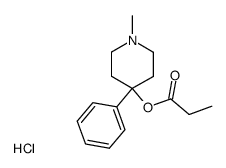1-methyl-4-phenyl-4-propionyloxypiperidine*HCl

1-methyl-4-phenyl-4-propionyloxypiperidine*HCl structure
|
Common Name | 1-methyl-4-phenyl-4-propionyloxypiperidine*HCl | ||
|---|---|---|---|---|
| CAS Number | 4968-48-3 | Molecular Weight | 283.79400 | |
| Density | N/A | Boiling Point | N/A | |
| Molecular Formula | C15H22ClNO2 | Melting Point | N/A | |
| MSDS | N/A | Flash Point | 35.6 °F | |
| Symbol |


GHS02, GHS07 |
Signal Word | Danger | |
| Name | 1-methyl-4-phenyl-4-propionyloxypiperidine*HCl |
|---|---|
| Synonym | More Synonyms |
| Molecular Formula | C15H22ClNO2 |
|---|---|
| Molecular Weight | 283.79400 |
| Exact Mass | 283.13400 |
| PSA | 29.54000 |
| LogP | 3.30060 |
| Symbol |


GHS02, GHS07 |
|---|---|
| Signal Word | Danger |
| Hazard Statements | H225-H302 + H332-H319 |
| Precautionary Statements | P210-P305 + P351 + P338 |
| RIDADR | UN 1648 3 / PGII |
| Flash Point(F) | 35.6 °F |
| Flash Point(C) | 2 °C |
|
Glioma cell death induced by irradiation or alkylating agent chemotherapy is independent of the intrinsic ceramide pathway.
PLoS ONE 8(5) , e63527, (2013) Resistance to genotoxic therapy is a characteristic feature of glioma cells. Acid sphingomyelinase (ASM) hydrolyzes sphingomyelin to ceramide and glucosylceramide synthase (GCS) catalyzes ceramide met... |
|
|
Gas-liquid chromatographic-mass spectrometric determination of 1-methyl-4-phenyl-4-propionoxypiperidine using a stable isotope-labeled analogue as an internal standard.
J. Chromatogr. A. 408 , 356-9, (1987)
|
|
|
Involvement of gangliosides in glucosamine-induced proliferation decrease of retinal pericytes.
Glycobiology 15(6) , 585-91, (2005) The hexosamine pathway (HP) is a biochemical hypothesis recently proposed explaining cellular alterations occurring during diabetic microvascular complications. Diabetic retinopathy is a common microv... |
| 3-desmethyl prodine hydrochloride |